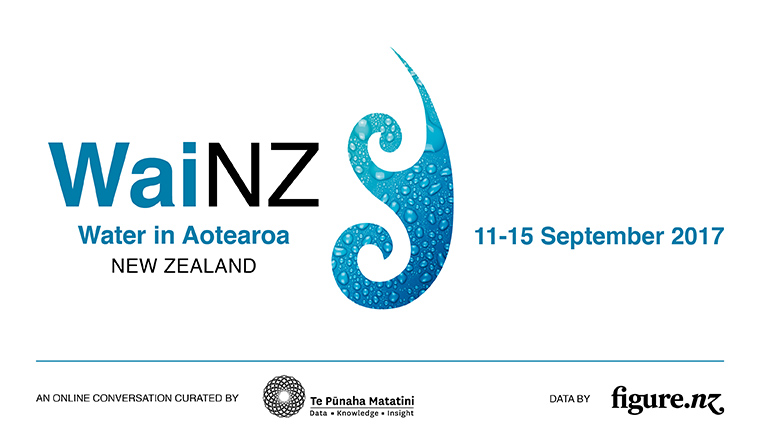Kia ora mai tātou,
Ngā mihi ki a tātou.
Tuatahi – tēnei te mihi nui ki ngā kaikōrero, mō rātou whakaaro, moemoea, wawata.
First – our huge thanks to the contributors, for their thoughts, dreams, aspirations.
Tuarua – tēnei te mihi ki a koutou katoa, mo to koutou tautoko.
Second – thanks to all of you who have participated.
Tuatoru – he mihi tino nui ki a FigureNZ mo tō rātou tautoko me pukengatanga o tēnei mahi whakahirahira.
Thirdly – a huge thank you to FigureNZ for their support and expertise on this important work.
We hope the stories that have been shared on WaiNZ have invoked some feelings in you. I certainly have traversed the full range of emotions – anger, disgust, sadness, frustration and despair at the state of water in Aotearoa New Zealand, described in the blogs. But those emotions were tempered with surprise and joy in formative memories shared, and in the collective message of hope for better outcomes for water, and with that hope I trust that we can make better decisions. My anticipation for those better decisions is almost palpable.
I want to expand on some recurring themes that flowed through the blogs. One of those is mauri, the capacity for air, water or soil to support life, the physical life principle, the spark of life. Mauri is a universal concept in Māori thinking and part of a holistic system, expressed beautifully in the idiom – ki uta, ki tai (from the mountains to the sea) – meaning what we do on land impacts the oceans. What is unwritten, but is implicit, is that it is our waterways that provide that connection. If our waterway is muddy – the mauri is compromised; if our waterway is choked with weed – its mauri is comprised; if our waterway is poisoned with pathogens or chemicals – its mauri is compromised; if you drink water and it makes you ill – its mauri is compromised; if our waterway only flows sporadically, or doesn’t flow at all – its mauri is compromised.
We don’t need techno-scientific data to tell us that it is compromised – we can see it, we can feel it. So, although mauri is a Māori word, it is a universal concept and, as many of us have seen and felt, the mauri of the majority of our waterways and increasingly our beaches, estuaries, harbours and oceans has been compromised. The hope I referred to earlier can be activated here – Te Mana o te Wai, for example, is conceptualised in terms of mauri. Mike Joy highlights concerns with the way that water data is represented. However, muddy rivers like those Mary Sewell spoke about don’t lie, rivers choked with weed don’t lie, rivers that are no longer there don’t lie, Siouxsie Wiles informed us about New Zealanders suffering from water-borne diseases that don’t lie, and as Tara McAllister showed us, dogs dying from eating toxins produced by Phormidium don’t lie. So while the empirical data being collected and (mis)represented is of concern, we can realise our own agency by drawing on our own collective experience and observations. Two great examples of where this is happening right now are shared by Ani Murchie and David Hamilton in Waitaha Canterbury and Waiariki, respectively.
The stark reality is that our waterways have been severely degraded and continue to be polluted. The Freshwater Rescue Plan Marnie Prickett discusses provides a beacon of hope, and appears to reflect and align with the hopes and aspirations of many New Zealanders.
I am also concerned with the way we treat water in our urban environments – as a nuisance, something to be controlled, and as a medium to transport our human waste. Civil engineering was once defined as ‘harnessing the powers of nature for human benefit’, however while definitions evolve with human understanding, some practices have not. The continued capture, control and burial of natural water courses is an example of the practice failing to stay abreast of evolving understandings and renewed relationships we seek with our waterways, our ancestors. We need to shift our thinking, as Auckland, for example, persists with live burial of natural water courses in new subdivisions while sporadic stream daylighting projects are show-cased as best-practice. We need to shift thinking away from the idea that ‘we only capture a small percentage of freshwater – the rest is wasted’. The Te Pūnaha Matatini project ‘Mai i ngā maunga ki te tai’ that is about to start is an example of shifted thinking – we draw from mātauranga Māori and complexity science.
We can do this New Zealand, and in fact we must.
Tuturu whakamaua kia tina, haumie, hui e, taiki e.
Siouxsie and Dan
About:
Dr Daniel (Dan) Hikuroa, a Principal Investigator at Te Pūnaha Matatini, is an earth systems scientist at the University of Auckland who integrates mātauranga Māori (Māori knowledge) and science to realise the dreams and aspirations of the communities he works with. Dan’s many projects include the co-writing of the 2014 State of the Hauraki Gulf Environment Report.
Dr Siouxsie Wiles is Deputy Director (Outreach and Public Engagement) of Te Pūnaha Matatini. She describes herself as a microbiologist and bioluminescence enthusiast. As Head of the Bioluminescent Superbugs Lab at the University of Auckland, Siouxsie combines her twin passions to understand the interplay between environment and infectious diseases.
What is WaiNZ?
Kia ora, Aotearoa. We’ve asked leading environmental, social and health researchers to share their personal and professional perspectives about the state of our water and what water means to us as New Zealanders. Follow their blogs right here at tepunhahamatatini.ac.nz and across social media with #WaiNZ.
Where possible, commentary will be backed up by data from Figure.NZ. Their incredible charts are based on data sourced from public repositories, government departments, academics and corporations. Check out their #WaiNZ data board and sign-up to create your very own data board on any topic that interests you.

